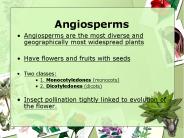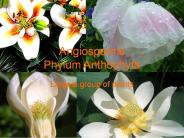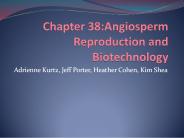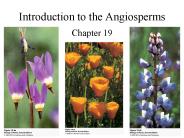Angiosperm PowerPoint PPT Presentations
All Time
Recommended
Angiosperms are the most diverse and geographically most widespread plants Have flowers and fruits with seeds Two classes: 1. Monocotyledones (monocots)
| PowerPoint PPT presentation | free to download
Angiosperms Pistil and Stamen male female Pistil and Stamen male female End of the Semester! Kobe Kuiz What is the reproductive structure of angiosperms called?
| PowerPoint PPT presentation | free to download
... Stamens, composed of anther organ that ... for the embryo to grow Mature ovule becomes the seed coat and/or fruit Monocot vs. Dicot Angiosperms are ...
| PowerPoint PPT presentation | free to download
Angiosperms Earth s dominant plants Angiosperm Characteristics Vascular Flowering plants Double fertilization Seeds are covered in a fruit Dominant sporophyte ...
| PowerPoint PPT presentation | free to view
Chapter 38 Angiosperm Reproduction Angiosperms have 3 unique Features: Flowers Fruits Double Fertilization (by 2 sperm) REPRODUCTIVE VARIATIONS Pollination: transfer ...
| PowerPoint PPT presentation | free to view
ANGIOSPERM FAMILY
| PowerPoint PPT presentation | free to download
... * Pollen Grains Taxonomically useful Most families Many genera Some species Widely represented in fossil record Palynology Undergo mitosis within pollen ...
| PowerPoint PPT presentation | free to view
Absolute Angiosperms. Magnoliophyta. Primitive Angiosperm Lineages. Amborella trichopoda ... Monocots vs. Eudicots. Eu- Monocots vs. Eudicots. Basal Eudicots ...
| PowerPoint PPT presentation | free to download
Angiosperm Reproduction & Biotechnology Alternation of Generations (Revisited) The life cycle of angiosperms and other plants are characterized by an alternation of ...
| PowerPoint PPT presentation | free to view
Angiosperms probably originated in the tropics. West Gondwana, equivalent to modern South ... 6. Generally hermaphrodite flowers and cross pollinating (70 ...
| PowerPoint PPT presentation | free to download
Supermarket Angiosperm True Fruits -A fruit is a ripened ovary -Carpels hold fertilized ovules -Depending on the type of plant, the mature ovary may form a juicy ...
| PowerPoint PPT presentation | free to download
The flower produces microspores within anthers and megaspores within ovules by meiosis. ... The portion of the flower that consists of a filament and an anther ...
| PowerPoint PPT presentation | free to view
Angiosperms Phylum Anthophyta Largest group of plants Angiosperms are flowering plants. They have true roots, stems, leaves and flowers... Angiosperms are more highly ...
| PowerPoint PPT presentation | free to download
Complete: all 4 floral organs (floral organs: sepals, petals, stamens ... Incomplete: lacking 1 or more floral. Perfect: both stamens and carpels on 1 flower ...
| PowerPoint PPT presentation | free to view
Mainly herbaceous. Parallel veins in leaves. Flower parts multiples of 3 ... Herbaceous or woody. Branched veins. Flowers multiples of 4 or 5. Seed 2 cotyledons ...
| PowerPoint PPT presentation | free to view
Title: Wednesday, September 5 Author: Peter Last modified by: valued customer Created Date: 8/16/2006 12:00:00 AM Document presentation format: On-screen Show (4:3)
| PowerPoint PPT presentation | free to download
Angiosperm Reproduction and Biotechnology Chapter 38 Angiosperms Anthophyta More specialized xylem evolved. Tracheids seen in gymnosperms gave rise to vessel elements ...
| PowerPoint PPT presentation | free to view
Classification of Angiosperms The Flowering Plants Two Major Groups Monocots Single cotyledon Parallel veins Flowers in multiples of 3 s Dicots Two cotyledons ...
| PowerPoint PPT presentation | free to download
... symmetry. Inflorescence Types. Inflorescences are the arrangement of flowers on the plant. ... Remnants of the sepals are seen in the pappus which is scale ...
| PowerPoint PPT presentation | free to view
Angiosperm Reproduction & Biotechnology Alternation of Generations (Revisited) The life cycle of angiosperms and other plants are characterized by an alternation of ...
| PowerPoint PPT presentation | free to view
Gymnosperm vs Angiosperm Flowers, Fruits and Seeds too Seed Plants Seed plants are plants that produce seeds in order to reproduce. Two types of seed plants exist ...
| PowerPoint PPT presentation | free to view
Angiosperm Leaf Types. Gymnosperm Leaf Types. Compound Leaves. Leaf Arrangement. Leaf venation. Leaf Edges, Margins, Shapes, Etc. Leaf Edges, Margins, Shapes, Etc. ...
| PowerPoint PPT presentation | free to view
Chlorophyll a,b and carotenoids in chloroplasts. Starch stored inside chloroplasts ... B. Frith. M. Ayasse. Flowering plants. Anthophyta Characteristics ...
| PowerPoint PPT presentation | free to view
Bulb: short stem enclosed in fleshy leaf bases. Corm: short, thickened underground stem not enclosed in ... Cambium: tissue to make more xylem and phloem cells ...
| PowerPoint PPT presentation | free to view
They reproduce sexually - producing flowers, fruits, and seeds ... The flower attracts insects and other types of pollinators insuring cross-pollination ...
| PowerPoint PPT presentation | free to view
Title: PowerPoint Presentation Author: OIT Last modified by: OIT Created Date: 3/16/2006 3:25:06 PM Document presentation format: On-screen Show Company
| PowerPoint PPT presentation | free to download
Animals- ex: insects. Attracted to brightly colored and sweet smelling flower. ... ex: water lilies. Animals- feed on fruit/berries. Stick to body-sticky, spiny seeds ...
| PowerPoint PPT presentation | free to view
ANGIOSPERMS (largest phylum in the plant kingdom) Flowers allow for efficient pollination. wind animals feed on pollen or nectar pollen is spread from plant to plant ...
| PowerPoint PPT presentation | free to view
Angiosperms The Flowering Plants Monocots Vs. Dicots Main Differences First Seed Leaves Leaf Differences - Vein Arrangement Monocots Dicots Examples Monocots ...
| PowerPoint PPT presentation | free to download
There is an amazing diversity of floral structures. ... In general flowers were diverse in the number of floral parts and in their arrangements. ...
| PowerPoint PPT presentation | free to download
Mechanisms That Prevent Self-Fertilization. Sexual reproduction is beneficial to genetic diversity. If plants reproduced always asexually, there would be no new genes ...
| PowerPoint PPT presentation | free to download
seeds are enclosed in fruits (mature ovaries) ... by comparing the genes that give rise to ... can have up to 4 rings of modified leaves called floral organs: ...
| PowerPoint PPT presentation | free to view
Angiosperms. Flowering plants. Parts of the flower. Lilium Anther right half of the structure ... Pollen Grain (n) (immature male gametophyte) Pollen sac ...
| PowerPoint PPT presentation | free to view
Spores are released: w/ mitotic divisions the gametophyte develops ... Ambrosia. Aesculus. Lilium. Mature microgametophyte. sperm cells. tube cell. Megasporangium ...
| PowerPoint PPT presentation | free to view
Angiosperm Reproduction AP Biology Unit 5 Flower Anatomy The flower is the reproductive organ of an angiosperm Female part = Carpel Consists of the stigma, style, and ...
| PowerPoint PPT presentation | free to view
There are generally hermaphrodite flowers and cross pollination between flowers ... Hermaphrodite: organism with the organs of both sexes. ...
| PowerPoint PPT presentation | free to view
The diagram above shows the breaking of seed dormancy (in a generalised grass/cereal seed). All seeds must absorb (imbibe) water to become metabolically active, ...
| PowerPoint PPT presentation | free to download
the transfer of pollen from an anther to a stigma ... 4. runner or stolons wispy stems that snake away from the parent plant and ...
| PowerPoint PPT presentation | free to view
Introduction to the Angiosperms Chapter 19 Angiosperms- Anthophyta Autotrophic, but parasitic and saprophytic representatives. Enclosure of ovules within carpels.
| PowerPoint PPT presentation | free to download
creates monoecious & dioecious plants. bilateral vs. radial symmetry ... dioecious plants. floral organs mature at different times ...
| PowerPoint PPT presentation | free to view
... root replaced by adventitious roots. Mostly herbs. Vascular ... Primary root replaced by adventitious roots. Leaves with parallel venation and sheathing bases ...
| PowerPoint PPT presentation | free to view
For many decades one of the big questions was whether the original angiosperms ... Evolution from Glossopterid-line of gymnosperms (Glossopteris or Gigantopteris) ...
| PowerPoint PPT presentation | free to view
diversity of color/scent/size/thickness/anther location. colored/scented to attract pollinators ... color, shape, scents. Pollination trend. water wind animal ...
| PowerPoint PPT presentation | free to view
... gametophytic apomixis (diplospory or apospory) adventitious embryony Apomixis in Citrus cell in the nucellus develops into an embryo, outside the embryo sac ...
| PowerPoint PPT presentation | free to download
| PowerPoint PPT presentation | free to view
Comparative mitochondrial zygomycetes: bacterial-like Rnase P RNAs, mobile elements and a close source of the group I intron invasion in angiosperm
| PowerPoint PPT presentation | free to download
Review of the Angiosperms ...
| PowerPoint PPT presentation | free to download
Angiosperm clade with N-fixing bacteria in nodules. Root nodules in soybean ... cyanobacteria (Nostoc punctiforma) in the leaf petiole ...
| PowerPoint PPT presentation | free to view
First 4 nucleate stage. Second 4 nucleate stage. Pollen grains. Chenopodium album pollen grain. Yellow pond lily. Nuphar lutea. Scotch Pine. Pinus sylvestris ...
| PowerPoint PPT presentation | free to view
Angiosperm origins and relationships of major lineages Vessels and tracheids Companion cells Pollen Fertilisation Development of Fruits Cycads Conifers Ginkgos ...
| PowerPoint PPT presentation | free to view
Parts of the flower. We covered 23.2 in lab you are responsible for this ... Nectar guides. Bee pollination. Bat pollination. Night blooming. Fragrant. Very ...
| PowerPoint PPT presentation | free to view
The life cycles of angiosperms and other ... Unisexual flower: dioecious. A dioecious plant has staminate flowers and carpellate flowers on separate plants. ...
| PowerPoint PPT presentation | free to view
Sexxxxuality in Angiosperms. Extreme reduction of the gametophyte ... Figure 38.1 Simplified overview of angiosperm life cycle. Figure 38.3d1 Pollination modes ...
| PowerPoint PPT presentation | free to view
Plant structure and growth stage ontologies to describe phenotypes and gene expression in angiosperm
| PowerPoint PPT presentation | free to download
Monocots & Dicots Types of Angiosperms Botany Angiosperms Angiosperms are flowering plants. Angiosperms belong to the division Magnoliophyta. Angiosperms can be ...
| PowerPoint PPT presentation | free to view
























































